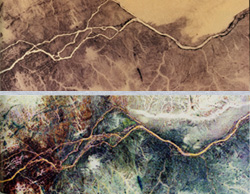
| In the last years, amongst all the
remote sensing scientific activities, the Earth observation is having a great success. This is both because of the remarkable progresses in the spatial missions
field and the technological progress reached in antennas projecting and building for the
Earth observation, antenna that have flown or still fly on satellites or spatial vectors
as Space Shuttle. |
Courtesy of NASA/JPL

Wadi Kufra, Libya |
In this field, Radar and, in particular, SAR
antennas (Synthetic Aperture Radar) are really becoming more and more interesting. A Radar
antenna has the characteristic to acquire data almost everywhere and in every time, either
with good or bad weather conditions and either with daylight or darkness on the observed
area. As a matter of fact, the electromagnetic waves sent out from these antennas in some
frequencies can pass the clouds through and, in some conditions, vegetation, ice or
particularly dry sand as well. By this instrument, then, it is possible to observe what is
under a dense rain vegetation or under the desert sand.
Courtesy
of NASA/JPL

Nile River, Sudan |
The Radar images study allowed the scientists to
discover really many archaeological areas as the riverbed that flowed in the Sahara desert
millions of years before the Nile existed or the lost town of Ubar or the archaeological
site of Angkor. |
In some cases, finally, the Radar is the only
mean the scientists have to observe some regions of the Earth surface particularly hard to
reach. |